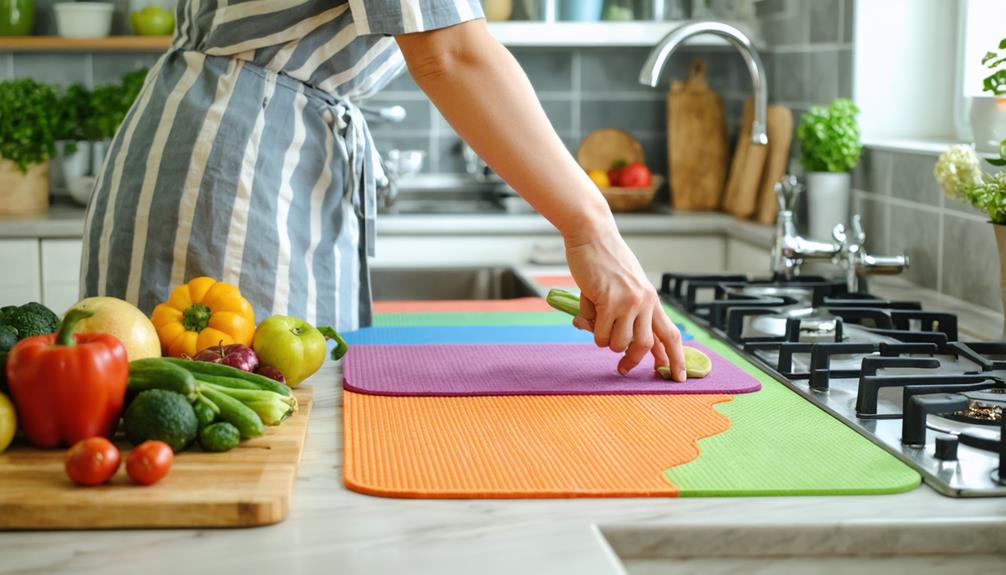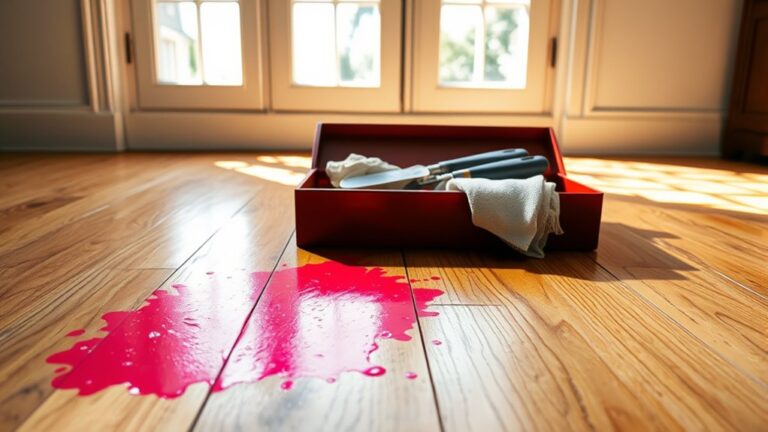Installing non-slip mats in your kitchen is essential for safety. They help reduce the risk of slips, trips, and falls, which are significant workplace hazards. When choosing your mats, opt for anti-slip options made from durable materials like rubber or nitrile, ideally with drainage holes for managing spills. Make certain to clean and dry the surface before placing the mats, and secure them properly to prevent shifting. Regularly inspect your mats for wear and maintain them to guarantee ongoing effectiveness. With the right knowledge, you'll create a safer kitchen environment where both staff and customers can feel secure.
Importance of Non-Slip Mats
In any kitchen, the importance of non-slip mats cannot be overstated. These mats greatly reduce the risk of slips, trips, and falls, which account for a staggering 37% of workplace injuries. In busy environments like kitchens, where spills are commonplace, having non-slip mats is essential for creating a safer workspace. By installing these mats, you're not just enhancing safety; you're also complying with the Health and Safety at Work Act, which is critical for protecting kitchen staff.
Kitchen mats are specifically designed to manage liquid spills effectively, often featuring drainage holes that help keep surfaces dry and minimize slip hazards. Additionally, anti-fatigue mats, a variant of non-slip mats, provide extra comfort by reducing muscle strain from prolonged standing. This added comfort can lead to increased productivity, allowing your kitchen staff to work efficiently even during the busiest shifts.
Regular maintenance and inspection of non-slip mats are important to guarantee their ongoing effectiveness. By keeping these mats in good condition, you're not only helping to maintain a safe food preparation area but also reducing the likelihood of accidents that can disrupt operations. Investing in high-quality non-slip mats is a proactive step toward fostering a safer, more productive kitchen environment. So, whether you're running a bustling restaurant or a small home kitchen, prioritizing non-slip mats will give you the freedom to work confidently and efficiently.
Types of Mats Available
When choosing mats for your kitchen, you'll find a variety of options tailored to specific needs. Anti-slip mats enhance grip and greatly reduce the risk of slips in areas prone to spills, while anti-fatigue mats offer cushioning to ease the strain on your legs and back during long hours of standing. Understanding these types will help you create a safer and more comfortable kitchen environment.
Anti-slip Mat Benefits
Choosing the right anti-slip mat can greatly reduce safety risks in your kitchen. These specialized matting products are designed to enhance grip in high-risk, wet areas, guaranteeing you can focus on your cooking without worrying about slips and falls. Here are three key benefits:
- Improved Piso Seguridad: Anti-slip mats effectively capture food debris and liquids, minimizing slip hazards. Mats made from 100% nitrile rubber with embossed textures are particularly effective in food prep areas.
- Drainage Solutions: Mats with drainage holes are essential for managing liquid spills. Look for circular holes for light spills or horizontal slats for better drainage during heavy spills, keeping your kitchen safe and clean.
- Durabilidad: High-quality mats, such as K-Mat and Fatigue-Step, resist oils and chemicals, making them perfect for commercial kitchen settings. Their durability guarantees that you won't have to replace them frequently, providing both safety and value.
Anti-fatigue Mat Features
Finding the right anti-fatigue mat can transform your kitchen experience, especially if you're on your feet for long periods. These mats are specifically designed to provide the cushioning you need, reducing stress on your legs and back. When selecting an anti-fatigue mat, look for a textured surface that enhances grip, making it a reliable non-slip mat in areas prone to spills.
Most anti-fatigue mats are made from durable materials like rubber or foam, ensuring both comfort and longevity. This is essential in high-traffic environments, where wear and tear can be a concern. Some models even incorporate drainage holes to effectively manage liquid spills, further enhancing safety and cleanliness during food preparation.
Safety Benefits of Mats
Using non-slip mats in your kitchen greatly reduces the risk of slips, trips, and falls, which are major contributors to workplace injuries. These mats not only enhance safety by absorbing spills but also provide cushioning that alleviates muscle strain during long hours of standing. By prioritizing both safety and comfort, you create a more efficient and secure working environment for everyone.
Preventing Workplace Injuries
In a bustling kitchen, the risk of slips, trips, and falls can be alarmingly high, accounting for 37% of workplace injuries. To combat this, installing non-slip mats is vital for preventing workplace injuries, especially in high-traffic food preparation areas. These mats not only enhance grip but also absorb spills, notably minimizing accident risks.
Consider the following benefits of non-slip mats:
- Seguridad mejorada: By providing a slip-resistant surface, these mats help reduce accidents caused by wet or slippery floors.
- Regulatory Compliance: Using non-slip mats supports your duty of care under the Health and Safety at Work Act, ensuring your kitchen meets safety regulations.
- Mantenimiento regular: It's important to inspect and maintain these mats regularly. Worn or damaged mats can lose their effectiveness, increasing the likelihood of injuries.
Enhancing Employee Comfort
Non-slip mats play an important role in enhancing employee comfort within busy kitchen environments. When you're standing for long periods, anti-fatigue mats greatly reduce muscle strain and discomfort, making your work experience more pleasant. This improvement not only boosts your overall comfort but also increases productivity, allowing you to focus on your tasks without the distraction of fatigue.
Moreover, the use of kitchen matting minimizes slips, trips, and falls, which account for a staggering 37% of workplace injuries. With enhanced traction from these non-slip mats, you can feel more secure, especially in areas prone to spills. They're designed to absorb spills and debris, which not only lowers risks but also promotes sanitation—a critical factor in maintaining a safe work environment.
Regular maintenance of these mats is essential; it prolongs their lifespan and guarantees ongoing slip resistance. By doing so, you're directly impacting employee safety and comfort in the kitchen. Investing in quality anti-slip mats isn't just about safety; it's about creating a supportive atmosphere where you can thrive and perform your best.
Additional Advantages of Mats
Mats offer a variety of advantages that go beyond just preventing slips and falls in the kitchen. When you invest in high-quality mats, especially anti-fatigue options, you're not only enhancing safety but also improving comfort for your employees who spend long hours in food service areas. Here are three additional benefits to reflect on:
- Mayor comodidad: Anti-fatigue mats provide cushioning that reduces muscle strain. This can lead to increased productivity, as your staff will feel less fatigued and more energized throughout their shifts.
- Floor Protection: Mats act as a barrier against damage from hot liquids and heavy equipment. By preserving your kitchen surfaces, you extend their lifespan and maintain a professional appearance, which is vital in a food service environment.
- Increased Hygiene: Many mats come with antimicrobial properties that inhibit bacteria growth. This is especially important in food preparation areas, where hygiene standards are paramount. Keeping bacteria at bay helps guarantee a safer environment for both your employees and customers.
Consejos de mantenimiento y cuidado
Maintaining the integrity of your non-slip mats is key to guaranteeing their continued effectiveness in promoting safety and comfort in the kitchen. Regular inspections are essential; check for signs of wear and tear, as worn mats can lose their slip-resistant properties, increasing fall risks in busy environments. Additionally, cleaning your mats frequently with appropriate solutions helps remove food debris and spills, safeguarding hygiene and maintaining slip resistance.
Utilizing mats with drainage holes can greatly aid in spill management, preventing liquid accumulation that creates hazardous conditions. When possible, choose mats that are machine washable, as this promotes better hygiene standards and extends their lifespan in high-traffic areas. Finally, schedule routine maintenance checks to assess the effectiveness of the slip-resistant features and replace any mats showing considerable wear or damage.
Here's a quick maintenance guide for your non-slip mats:
| Tarea | Frecuencia | Notas |
|---|---|---|
| Inspect for wear | Semanalmente | Look for tears or fading color |
| Clean with solutions | Semanalmente | Use non-abrasive cleaners |
| Check drainage holes | Mensual | Verify holes are clear and functional |
| Machine wash (if allowed) | Bi-monthly | Follow care instructions |
| Replace damaged mats | Según sea necesario | Prioritize safety to prevent falls |
Identifying High-Risk Areas
Identifying high-risk areas in your kitchen is crucial for guaranteeing a safe working environment. These zones are where the likelihood of slipping and falling is greatly heightened due to moisture, food spills, or high traffic. Pinpointing these spots enables you to take proactive measures, like installing non-slip mats, to enhance safety.
Here are three key high-risk areas to focus on:
- Sinks and Dishwashers: Water accumulation around sinks and dishwashers can lead to slippery surfaces. Non-slip mats in these areas provide a crucial barrier against accidents.
- Cooking Stations: The area surrounding cooking stations often sees spills from oils and food. Using anti-slip mats here not only lessens slipping hazards but also supports a more efficient workflow.
- Entry Points and Walkways: Paths where employees frequently move between food prep and service areas are prone to spills. Installing low-profile non-slip mats helps maintain smooth movement while reducing tripping risks.
Regularly evaluating high-traffic zones, especially those prone to spills, is essential. This guarantees you identify additional locations needing non-slip mat solutions, creating a thorough approach to kitchen safety. By addressing these high-risk areas, you not only protect your staff but also foster a workplace where everyone can feel free to move about safely.
Choosing the Right Mat
When it comes to enhancing safety in your kitchen, choosing the right non-slip mat is essential. Start by selecting anti-slip mats made of rubber or silicone; these materials provide superior grip and traction, especially in environments prone to spills. Look for mats designed to manage liquid effectively. Those with drainage holes or slats can help mitigate slip hazards in high-risk wet areas, guaranteeing any spills are quickly funneled away.
If your kitchen involves standing for long periods, consider incorporating anti-fatigue mats. These mats offer cushioning that alleviates stress on your legs and back, enhancing comfort and productivity. They can make a significant difference during those busy shifts, allowing you to focus on your tasks rather than discomfort.
Next, verify that the dimensions and thickness of your chosen mat are appropriate for the space. Mats that are too thick can create tripping hazards, while those that are too small may not provide adequate coverage. Check the mats regularly for wear and tear, replacing any that show signs of damage to maintain ideal slip-resistant properties.
Proper Installation Steps
Guaranteeing safety in the kitchen begins with proper installation of non-slip mats. To maximize adhesion and minimize slipping hazards, follow these essential steps:
- Clean and Dry the Surface: Before you lay down your matting, make sure the floor is thoroughly cleaned and completely dry. This is vital, as dirt or moisture can prevent your mat from adhering properly, leading to potential slips.
- Choose the Right Mat: Opt for mats that feature appropriate drainage for liquid spills, as these are common in kitchens. Mats made from 100% nitrile rubber offer enhanced traction and are easier to keep clean, providing a safer environment.
- Secure Your Mats: Once you've positioned your mat, secure it using adhesive strips or suction cups, particularly in high-traffic areas. This prevents movement and reduces the risk of tripping hazards, guaranteeing that your mat stays in place while you cook.
Additionally, be mindful of mat placement. Confirm they lie flat and align with surrounding furniture to avoid folds or wrinkles that could create additional hazards. Proper installation not only enhances safety but also prolongs the life of your mats. By following these steps, you can create a safer kitchen environment, allowing you the freedom to focus on what you love—cooking!
Regular Inspection Practices
Regular inspections of non-slip mats are important for maintaining a safe kitchen environment. To minimize the risk of slipping, you should conduct routine inspections at least once a month. This will help you assess the mats' condition and guarantee they retain their slip-resistant properties. During these inspections, look for signs of wear and tear, like cracks, tears, or flattened areas. Any damage can compromise the mats' effectiveness and safety, making it essential to act promptly.
In addition to visual inspections, regularly clean your mats to prevent dirt accumulation. Grime can considerably reduce traction, increasing the risk of slipping. A clean surface is critical for peak performance, so make this a part of your routine. If you notice any worn or damaged mats during your inspections, replace them immediately to maintain a safe working environment. Remember, 37% of workplace injuries stem from slips, trips, or falls, emphasizing the importance of proactive maintenance.
Preguntas frecuentes
Should You Have a Mat in Front of Kitchen Sink?
Yes, you should definitely have a mat in front of your kitchen sink. The kitchen sink benefits from a mat that absorbs spills, reducing slip risks. Consider mat material options like rubber or microfiber for maximum safety and comfort. Remember to clean your mat regularly; a simple wash with mild detergent keeps it effective and hygienic. By using a mat, you enhance your kitchen's safety while enjoying a more comfortable cooking experience.
How Do I Get My Kitchen Mats to Stay in Place?
Getting your kitchen mats to stay put can feel like trying to catch a slippery fish! Start by choosing heavy-duty kitchen mat materials designed for high foot traffic. Consider mat size carefully; larger mats can cover more area and reduce movement. For maintenance, keep the surface clean and dry, and use adhesive strips or double-sided tape for extra grip. Regularly inspect for wear, ensuring they're flat and free from folds or wrinkles.
How Do I Keep My Kitchen Floor Mats From Sliding?
To keep your kitchen floor mats from sliding, consider using mats made from textured materials that enhance grip. Using adhesive strips or double-sided tape can secure them firmly in place, ensuring floor safety during heavy foot traffic. Opt for heavier mats, as their weight helps maintain stability. Regularly clean both the mats and the floor beneath to prevent moisture buildup. Finally, choose mats with beveled edges to minimize tripping hazards while complementing your kitchen decor.
Where Do You Put Anti-Slip Mats?
When you're maneuvering the bustling dance of kitchen traffic patterns, think strategically about where to place your anti-slip mats. Position them near sinks, cooking stations, and entry points to catch those unexpected spills. Consider mat material options that offer cushioning benefits, providing comfort underfoot during long hours. Don't forget to assess and adjust placement as needed, ensuring you're always dancing safely through your culinary adventures, free from slip hazards lurking beneath.




